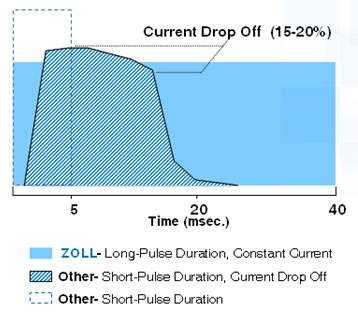Pacing
As the inventor of pacing technology, Dr. Paul Zoll, a founder of ZOLL Medical, performed the first human clinical cardiac pacing procedure in 1952. Today, the company named for him leads the way with patented external pacing technology that is incorporated into our AED and electrode products.
Why Pacing Matters
Pacing is a Class I intervention for symptomatic bradycardias (ILCOR, ERC & AHA Guidelines). Pacing is also used with a complete heart block.
How ZOLL Pacing Works
ZOLL defibrillators provide twice the capture at half the current; a 40-millisecond pulse with constant current is utilised. This means less patient discomfort.
Pacing Waveform Comparison
The ideal pacer current is the lowest value that maintains capture—usually about 10% above threshold. Typical threshold currents range from 40 to 80 milliAmps.
ZOLL's constant current, 40-msec pulse overcomes disadvantages inherent in other external pacemakers.
Pacing technology design differences greatly impact capture rates and patient survival. Independent clinical studies and widespread use of ZOLL's patented pacing pulse has proven to be the most effective noninvasive technology available.
|
 |
ZOLL incorporates a unique technology in all of its professional defibrillators. Pressing and holding the 4:1 button temporarily withholds pacing stimuli, thereby allowing you to observe the patient’s underlying ECG rhythm and morphology without losing capture. When depressed, this button causes pacing stimuli to be delivered at one-fourth of the indicated ppm setting.
Proper pacing requires a reliable, high quality surface ECG signal. ZOLL helps ensure proper pacing with OneStep™ Pacing electrodes or OneStep™ Complete electrodes. These hands-free therapy pads include both ECG monitoring and pacing/defibrillation electrodes in a single pad assembly. They provide reliable ECG monitoring without the need to use separate ECG leads.
References:
Dunn, Gregory, Noninvasive temporary pacing: experience in a community hospital, Heart and Lung. 1989;18:23-28.
Clinton, E, Antman, Zoll PD, Zoll R.H., External noninvasive temporary cardiac pacing: clinical trials. Circulation. 1985;71:937-944.
Heller, et al. A comparative study of five transcutaneous pacing devices in unanesthetized human volunteers. Prehospital and Disaster Medicine. 1989;4:15-18.
Falk, Zoll PM, Zoll RH, Safety and efficacy of noninvasive cardiac pacing. New England Journal of Medicine. 1983;309:1166-1168.
Knowlton Falk, External cardiac pacing during in-hospital cardiac arrest. American Journal of Cardiology. 1986;57:1295-1298.

